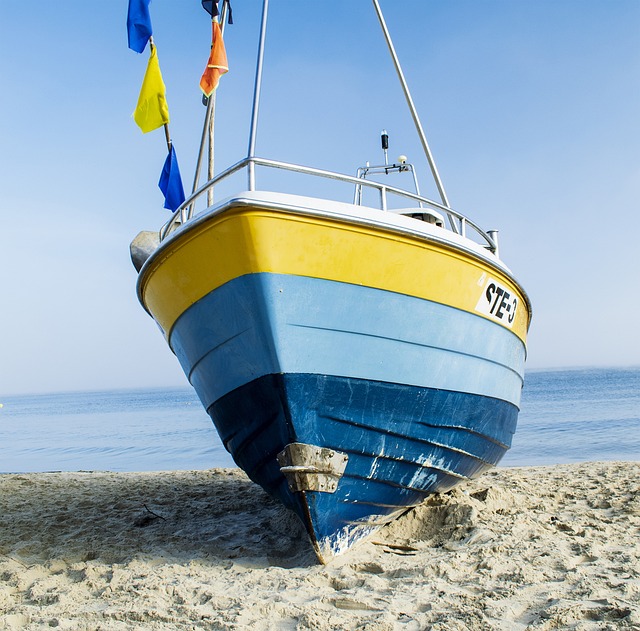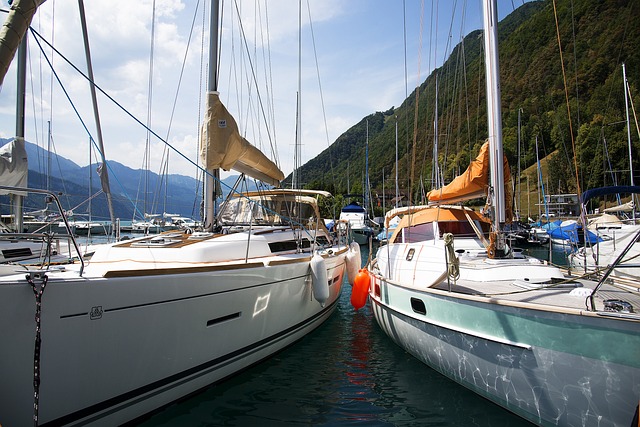Marine batteries play a critical role in ensuring the reliability of vessels at sea, withstanding harsh conditions like saltwater corrosion and extreme temperatures. There are two primary types: traditional lead-acid batteries, valued for their robustness and deep discharge tolerance; and AGM or SLA batteries, which are maintenance-free and offer longer lifespans, better resistance to vibration and temperature changes. Lead-acid batteries, while reliable, require regular maintenance to prevent issues like sulfation. AGM or SLA batteries deliver higher energy density, crucial for starting engines and powering electronic devices consistently. When selecting a marine battery, it's important to consider the specific power requirements of your vessel to ensure optimal performance and longevity. Proper maintenance, including smart chargers with intelligent charge algorithms, regular terminal cleaning, and shielding from extreme temperatures, is key to a marine battery's efficient operation and extended service life, which is essential for safety and a pleasant maritime experience.
To prolong the lifespan of your marine battery, it's vital to monitor charging levels, check terminals regularly, maintain proper water levels in lead-acid batteries, and employ conservation strategies like powering down electronics when not in use and using alternative power sources like solar panels or generators while underway. Strategic planning and understanding the impact of electronic devices on battery life can significantly enhance the durability of your marine battery. Regular inspections for damage, cracks, or bulging, along with secure vent caps, are crucial for preempting safety issues. Selecting a battery with higher capacity than needed can ensure long-term reliability, especially if upgrading your vessel's electrical systems. By following these maintenance practices and choosing the right battery for your needs, you can maximize service life and maintain consistent operation on the water. Keyword: marine battery conservation.
When embarking on maritime adventures, the reliability of your marine battery is paramount. This article delves into the nuances of marine battery types and their critical roles, offering insights to enhance your understanding. Learn the optimal charging practices that contribute to a robust battery life, and the significance of routine maintenance and inspections for long-term performance. Discover strategies for deploying your battery effectively to prevent unnecessary drain, and gain clarity on when and how to upgrade or replace your marine battery to ensure peak operation. With these tips in hand, you’ll keep your vessel’s power source in top condition, ready for the high seas.
- Understanding Marine Battery Types and Their Roles
- Optimal Charging Practices for Maximizing Marine Battery Life
- The Importance of Regular Maintenance and Inspection
- Strategic Deployment to Avoid Unnecessary Drain on Your Marine Battery
- Upgrading and Replacing Your Marine Battery: When and How to Do It Right
Understanding Marine Battery Types and Their Roles

When it comes to ensuring the reliability of your marine vessels, understanding marine battery types and their roles is paramount. Marine batteries are specifically designed to withstand the harsh conditions found at sea, such as saltwater corrosion, extreme temperatures, and the dynamic charging demands of maritime environments. There are primarily two types of marine batteries: lead-acid and absorbed glass mat (AGM) or sealed lead-acid (SLA) batteries.
Lead-acid batteries have been the traditional choice for many years due to their robust construction and reliability. They are known for their high tolerance to deep discharge cycles, which is a common occurrence in marine applications where systems may be unused over extended periods. However, they require regular maintenance, including checking and topping up of electrolyte levels, and are more susceptible to issues like sulfation if not properly maintained.
On the other hand, AGM or SLA batteries offer a maintenance-free alternative. These batteries have a longer lifespan and are less prone to the effects of vibration and temperature fluctuations, which can be particularly beneficial in a marine setting. They also have a higher energy density, providing more power for starts and sustained power for trolling and electronic equipment. When selecting a marine battery, it’s crucial to consider the specific needs of your vessel, including the size, power requirements, and expected usage patterns. Properly maintaining and understanding the type of marine battery you have will ensure that it operates efficiently and has a longer service life, which is essential for safety and enjoyment on the water.
Optimal Charging Practices for Maximizing Marine Battery Life

To ensure the longevity and reliability of your marine battery, it’s crucial to adopt optimal charging practices tailored for this specific application. Marine batteries are designed to handle the unique demands of boating environments, which often include frequent deep discharges and exposure to corrosive salts. To maintain peak performance, avoid overcharging by setting up a charger with an intelligent charge algorithm that automatically adjusts the charging rate based on the battery’s state of charge. Regularly check and clean the terminals and cable connections to prevent any loss of energy due to poor contacts. Additionally, store your marine battery in a cool, dry place when not in use, away from direct sunlight or extreme temperatures, as these conditions can degrade the battery’s performance over time. Investing in a high-quality marine battery charger with an automatic charging rate (ACR) feature can also significantly enhance your battery’s lifespan by providing the correct voltage and current for different stages of charging—initialization, absorption, float, and maintenance.
When using your marine battery, be mindful of the depth of discharge (DoD). Consistently running the battery down to a significant percentage of its capacity can accelerate wear. Ideally, aim to keep the DoD within a safe range that avoids deep discharges, as this will prolong the battery’s lifespan and reduce the risk of sulfation, which occurs when lead sulfate crystals form on the plates, reducing the battery’s ability to hold a charge. Regular maintenance, including checking electrolyte levels and adding distilled water as needed, is also important for maintaining optimal performance. By following these charging practices and paying close attention to your marine battery’s usage patterns, you can maximize its lifespan and ensure it operates reliably whenever you set sail.
The Importance of Regular Maintenance and Inspection

To ensure the longevity of a marine battery, regular maintenance and thorough inspections are indispensable practices for any seafarer or vessel owner. The harsh maritime environment often subjects these batteries to extreme temperatures and saline conditions, which can accelerate wear and tear, diminishing their performance and lifespan. Routine checks should be conducted to monitor the battery’s charge levels, as well as to inspect the terminals for signs of corrosion or looseness. Cleaning the terminals with a non-abrasive brush and applying a coat of anti-corrosion spray can maintain optimal conductivity and prevent electrical loss. Additionally, ensuring the water levels in flooded lead-acid batteries are at the proper specific gravity is crucial for their functioning. This proactive approach to maintenance not only extends the operational life of the battery but also safeguards against unexpected failures that could leave you stranded at sea. Regularly examining the battery’s case for cracks or bulging, and its vent caps for proper sealing, can help preemptively address potential issues before they become safety concerns. By implementing these maintenance measures, marine battery longevity is significantly increased, ensuring that when you set sail, your power source is reliable and ready to perform.
Strategic Deployment to Avoid Unnecessary Drain on Your Marine Battery

To ensure your marine battery maintains its longevity, it’s crucial to employ strategic deployment practices during its use. Regularly powering down and disconnecting electronic devices when not in use is a simple yet effective measure. Many marine batteries are drained more quickly by accessories like GPS units, fish finders, and VHF radios than by the trolling motor itself. By turning these off or unplugging them when they’re not needed, you significantly reduce unnecessary drain.
Additionally, it’s advisable to avoid deep discharge cycles if possible. Deeply discharging a marine battery can shorten its lifespan and lead to a reduced ability to hold a charge over time. Plan your trips and activities with battery conservation in mind. For instance, if you know you’ll need to use the electronics extensively, ensure the battery is fully charged before departing. Employing solar panels or a generator to keep the battery partially charged while underway can also be beneficial. By understanding and utilizing these strategies, you can extend the life of your marine battery and ensure it remains reliable for all your maritime endeavors.
Upgrading and Replacing Your Marine Battery: When and How to Do It Right

Regular maintenance and smart usage can significantly extend the life of a marine battery, which is subject to demanding conditions on the water. When the time comes to upgrade or replace your marine battery, it’s crucial to assess both the battery’s performance and the demands of your boating activities. Typically, mariners should consider replacing their batteries every 3 to 5 years, depending on usage frequency and conditions. However, this timeline can vary; for instance, a battery that is frequently subjected to deep discharges may need replacement more often.
Before upgrading, evaluate your specific needs based on the size of your vessel, the types of electronics you use, and the duration of your trips. AGM (Absorbent Glass Mat) or lithium batteries are popular choices for marine applications due to their durability and resistance to vibration and shocks. When upgrading, opt for a battery with a higher capacity than your current one to future-proof your setup, especially if you anticipate adding more electrical components to your boat. During the replacement process, ensure that all connections are clean, tight, and free of corrosion to prevent any issues that could shorten the life of your new battery. Proper installation and maintenance will not only ensure optimal performance but also contribute to a longer service life for your marine battery.
When it comes to ensuring your marine battery’s longevity, understanding the different types and their specific roles is paramount. Regular charging practices optimized for marine batteries can significantly extend their service life. Routine maintenance and frequent inspections are non-negotiable for maintaining peak performance. Strategic deployment of your marine battery, considering its capacity and usage patterns, can prevent unnecessary strain. Lastly, knowing when to upgrade or replace your marine battery is crucial for sustained reliability on the water. By adhering to these guidelines, you’ll enhance the lifespan and efficiency of your marine battery, ensuring a dependable power source for all your nautical adventures.
